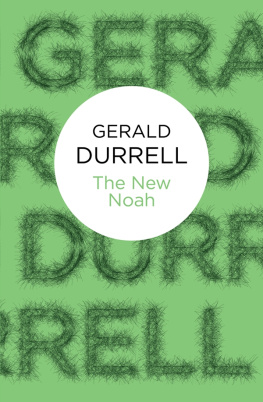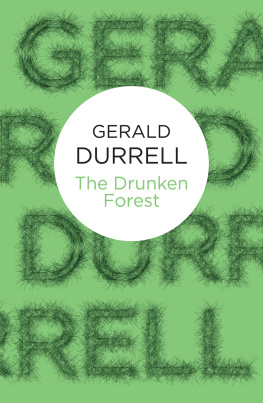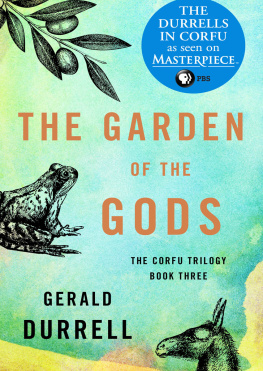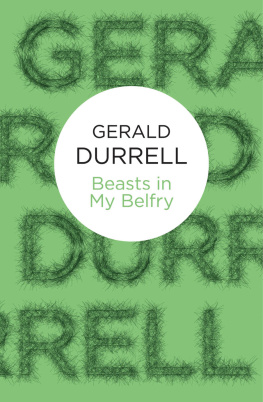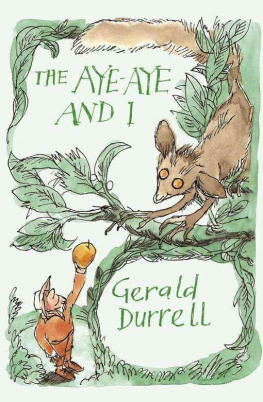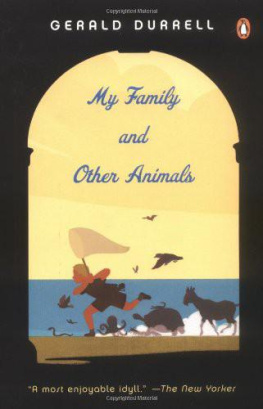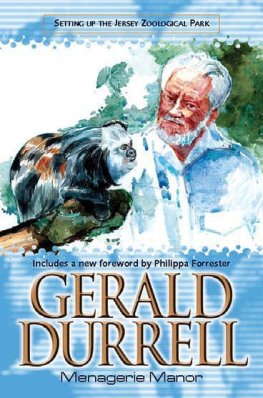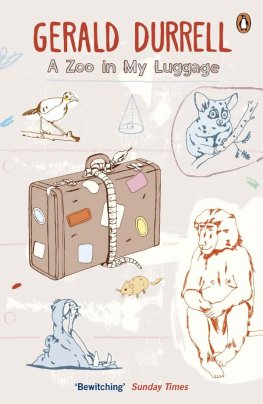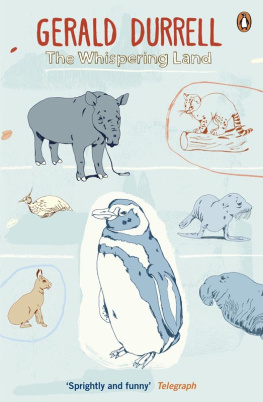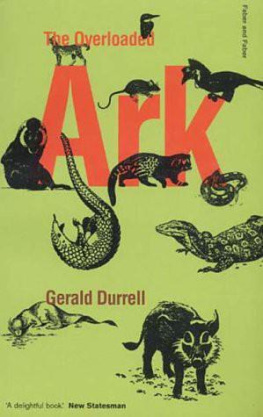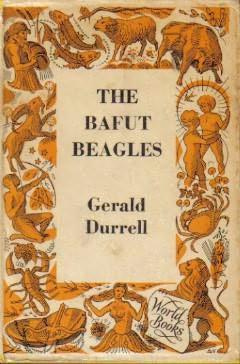Gerald Durrell - The New Noah
Here you can read online Gerald Durrell - The New Noah full text of the book (entire story) in english for free. Download pdf and epub, get meaning, cover and reviews about this ebook. year: 2012, publisher: Pan Macmillan, genre: Detective and thriller. Description of the work, (preface) as well as reviews are available. Best literature library LitArk.com created for fans of good reading and offers a wide selection of genres:
Romance novel
Science fiction
Adventure
Detective
Science
History
Home and family
Prose
Art
Politics
Computer
Non-fiction
Religion
Business
Children
Humor
Choose a favorite category and find really read worthwhile books. Enjoy immersion in the world of imagination, feel the emotions of the characters or learn something new for yourself, make an fascinating discovery.
- Book:The New Noah
- Author:
- Publisher:Pan Macmillan
- Genre:
- Year:2012
- Rating:5 / 5
- Favourites:Add to favourites
- Your mark:
- 100
- 1
- 2
- 3
- 4
- 5
The New Noah: summary, description and annotation
We offer to read an annotation, description, summary or preface (depends on what the author of the book "The New Noah" wrote himself). If you haven't found the necessary information about the book — write in the comments, we will try to find it.
The New Noah — read online for free the complete book (whole text) full work
Below is the text of the book, divided by pages. System saving the place of the last page read, allows you to conveniently read the book "The New Noah" online for free, without having to search again every time where you left off. Put a bookmark, and you can go to the page where you finished reading at any time.
Font size:
Interval:
Bookmark:

This book is for my niece
SAPPHO JANE
and my nephews
GERALD MARTIN
and
DAVID NICHOLAS
Most people at one time or another pay a visit to the zoological gardens. While there, they are so interested in the animals to be seen that they do not stop to wonder how a great many of them got to the zoo in the first place.
Now I am an animal collector and my job is to travel to the faraway places where these beasts live, and bring them back alive for the zoos. In this book I have described three animal-collecting trips that I have taken to various parts of the world, and have tried to show how the difficult but interesting job of collecting is done.
Most people have no idea of the hard work and worry that goes into a collecting trip to produce the fascinating birds and animals that they pay to see in the zoo. One of the questions that I am always asked is how I became an animal collector in the first place. The answer is that I have always been interested in animals and in zoos.
According to my parents, the first word I was able to say with any clarity was not the conventional Mamma or Dadda, but the word Zoo, which I would repeat over and over again in a shrill voice until someone, in order to shut me up, would take me to the zoo. When I grew a little older, we lived in Greece and I had a great number of pets, ranging from owls to sea-horses, and I spent all my spare time exploring the countryside in search of fresh specimens to add to my collection of pets. Later on I went for a year to Whipsnade Zoo, as a student keeper, to get experience of the larger animals, such as lions, bears, bison, and ostrich, which were not so easy to keep at home. When I left, I luckily had enough money of my own to be able to finance my first trip and I have been going out regularly ever since then.
Though a collectors job is not an easy one and full of many disappointments, it is certainly a job which will appeal to all those who love animals and travel. In this book I have tried to show that the hard work and disappointments are nearly always more than offset by the thrill of your successes and the excitement and pleasure not only of capturing your animals but of seeing them alive in their natural haunts.
Before starting out on a collecting trip you have to know what wild animals are wanted by the zoos; then, knowing their whereabouts, you choose those areas in which not only the specimens required are to be found, but other rare creatures as well. Zoologists and biologists, generally, have not the time or the money to travel to these distant corners of the earth to find out about wild life on the spot. Therefore, the animals have to be caught and brought back to them so that they can be studied more conveniently in the zoo. Now, the larger and commoner creatures from most parts of the world are well represented in nearly all zoological collections, and quite a lot is known about them. So it was the smaller and rarer beasts, about which we know so little, that I wanted to collect. It is about them that I am going to write.
From many points of view it is sometimes the small animals in a country that influence man more than the large ones. At home, for instance, the brown rat does more damage every year than any of the larger creatures. It was for this reason that I concentrated during my collecting trips on the smaller forms of life. For my first expedition I chose the Cameroons, since it is a small, almost forgotten corner of Africa, which is more or less as it was before the advent of the white man. Here, in the gigantic rain forests, the animals live their lives as they have done for thousands of years.
It is of great value to get to know and study these wild creatures before they are influenced by civilization, for wild animals can be affected just as much by change as people. One of the results of cutting down forests, building towns, damming rivers, and driving roads through jungle, is an interference with their way of life, and they have either to adapt themselves to the new conditions or die out.
It was my intention to find out all I could about the animals of the great forests and to bring back as big and varied a collection as possible of its small fauna, the creatures that the African calls in pidgin English, small beef.
When I arrived in the Cameroons for the first time what struck me most was the very vivid colouring of the undergrowth and the enormous size of the trees. There were leaves of every shade of green and red imaginable, from bottle green to pale jade, and from pink to crimson. The trees towered up to two and three hundred feet into the air, their trunks almost the circumference of a factory chimney, and their massive branches weighed down with leaves and flowers and great coiling creepers.
I landed at the little port of Victoria and had to spend a week or so there, preparing for the journey into the interior. A great many things had to be done before I could start on the actual work of collecting. There were Africans to engage as cooks or houseboys, various stores to buy and a great many other things as well. Also, the necessary permits to hunt and capture the animals I was after had to be obtained, for all the animal life in the Cameroons is strictly protected and, unless you obtain Government permission, you are not allowed to capture or kill any animals or birds. Eventually, when all this had been done, a lorry was hired and the food and equipment piled into it, and I set off. In those days there was only one way leading into the interior of the Cameroons and this, if followed far enough, led you to the village of Mamfe on the banks of the Cross River, some 300 miles from the coast. It was at this village I had chosen to make my base camp.
The earth you find in the Cameroons is red, very like the earth you see in Devon, and so the road, winding through the hills, was a bright brick colour, lined on each side by immense forest trees. As we drove along, I could see hosts of brilliant birds feeding in the trees, tiny glittering sun-birds sipping nectar from the flowers, great glowing plantain-eaters, like giant magpies, eating wild figs; and sometimes the passage of the lorry would frighten a flock of hornbills which would fly off across the road, making tremendous swishing noises with their wings, and honking dismally.
In the short undergrowth at the side of the road scuttled large numbers of agama lizards. These reptiles are almost as bright in colour as the birds, for the males have vivid orange heads, and the body is decked out in blue, silver, red, and black, while the females are rose-coloured with bright apple-green spots. They have a curious habit of nodding their heads vigorously up and down, and look very peculiar dashing here and there in pursuit of each other, suddenly stopping to nod their brightly-coloured heads. Almost as numerous as these lizards were the pygmy kingfishers, minute little birds, smaller than a sparrow, with bright blue backs, orange shirt fronts, and coral red beaks and feet. Unlike the English kingfisher, these little birds live on locusts, grasshoppers, and other insects. Dozens of them were perched on the telegraph wires, or on the stumps of dead trees on the roadside, all peering down hopefully into the grass and bushes below. Occasionally, one of them would drop off his perch like a stone and, when he fluttered out of the grass again, a grasshopper that was almost the same size as himself would be clutched firmly in his beak.
Three days after leaving the coast I reached Mamfe. I had chosen this village as a base camp for a variety of reasons. When you are collecting wild animals you have to choose your base very carefully: it has to be within fairly easy reach of some sort of store, so that you can obtain sufficient supplies of tinned food, nails, wire netting, and other important things, and also it has to be fairly near a road, so that when the time comes to depart you can bring your lorries near enough to the camp to load up.
Next pageFont size:
Interval:
Bookmark:
Similar books «The New Noah»
Look at similar books to The New Noah. We have selected literature similar in name and meaning in the hope of providing readers with more options to find new, interesting, not yet read works.
Discussion, reviews of the book The New Noah and just readers' own opinions. Leave your comments, write what you think about the work, its meaning or the main characters. Specify what exactly you liked and what you didn't like, and why you think so.

